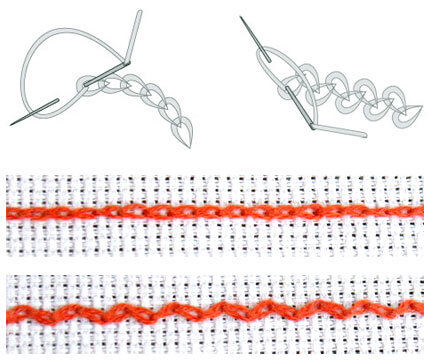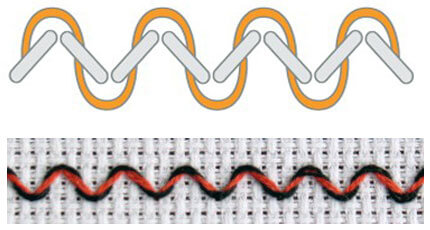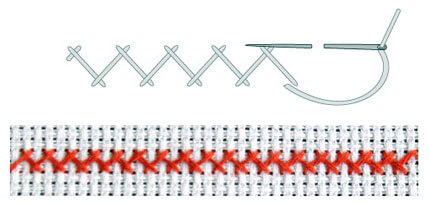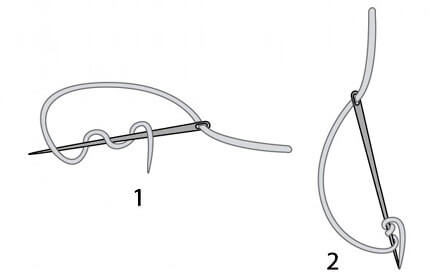 Do-it-yourself cross stitch bookmark
Do-it-yourself cross stitch bookmarkTypes of Ornamental Stitching

The simplest stitches
The simplest stitches dominate any types of embroidery. Rushnyk (an embroidered towel), hemstitch, Rococo (queen) embroidery make use of those stitches, and ribbon and beaded embroidery are based on them. You can also compose them into arrangements to be used for clothing ornamentation. Patchwork widely uses the ornamental stitches to veil and decorate stitches. The simplest stitches may also encompass the ornamental and marginal stitches.
Running Stitch
This includes a range of same length stitches and spacings. It is easy to stitch on canvas against the cells. For instance, overlap one cell, underlap the other. Changing the size and position of stitches in this seam may create a wide variety of embroidery for ornamenting table-napkins, rusnyks and clothing. The stitches may be arranged in one and more rows as the pattern applied specifies. The Millet is one of the options that implements this seam.
Back Stitch
The back stitch or backstitch makes a continuous raw of stitches. Fasten off the thread, make a first stitch from right to left and skip down one space, for instance, a cell on canvas. To make your second stitch, lay down the thread from left to right. Insert the needle into the same point where the first stitch ends, and pull it out on the front side one cell to the left from the second stitch. The reverse side stitch is thus twice longer than the front one. Stitches of this seam must have the same length.
Stem Stitch
This produces a continuous row of tightly fitted slant stitches. Having completed the first forward moving stitch on the fabric, bring the needle and thread beside the middle of and to the left from the completed stitch; press them to the fabric. Proceed with the second stitch piercing the fabric above the first stitch, and bring the needle back beside the middle of and to the left from the completed stitch. Move needle backward when stitching. Thereby, each new stitch moves ahead by half of the preceding stitch. The stem stitching keeps the working thread always to one side, either right or left. Keep the same direction of stitching, otherwise the stitch structure may be affected. All the stitches should be of same length.
Chain Stitching
The chain stitching comprises a continuous raw of loops spawning each other. The seam runs from right to left. Fasten off your needle first, pull it out on the front side; loop it back, make the first small stitch of 3 to 4 mm and put the needle out. The loop tightens the thread. Loop the thread again and insert the needle into the spot that it went out through with the preceding stitch. This seam may run as a zigzag-shaped band. Such pattern arranges the loops in sequence over the face side so that one is to the right and the other is to the left from midline of the seam. The chain stitch seam comprises a continuous raw of loops spawning each other. The seam runs from right to left. Fasten off your needle first, pull it out on the front side; loop it back, make the first small stitch of 3 to 4 mm and put the needle out. The loop tightens the thread. Loop the thread again and insert the needle into the spot that it went out through with the preceding stitch. This seam may run as a zigzag-shaped band. Such pattern arranges the loops in sequence over the face side so that one is to the right and the other is to the left from midline of the seam.
The Wormling Stitch
Runs from right to left, threads of two colours. One colour stitches a zigzag-shaped line. For that purpose, loop the working thread crornerwise from right to left so as to secure it; here comes your first stitch! Needle the first stitch from its top and pull the thread to the left bottom corner of the next square. Go on repeating the initial stitch until after the row completes. Once the run is done, sew the missing the stitch from left to right. Loop a contrast colour thread securing it on the reverse side, wrap the stitches.
Cross Stitching
A cross stitch comprises two crossed stitches. When making this stitch observe that the top stitch runs into a single direction. Having secured the twice folded thread, pull it out on the front side; stitch from the left bottom corner to the top right corner (Fig. 1). Complete the required number of stitches with a half cross stitch. Next, cover the half-cross stitching from the top left corner to the right bottom corner. The horizontal bands come from inside out.
Herringbone Stitching
The stitches run from left to right needling the fabric at one and the other edge of the band in sequence. Observe the same distance between the punctures. Within the band, the stitches cross. Each new stitch overlaps the preceding one. This stitch embroiders leaflets, core of flowers. Even bands of this seam complement large, complex embroideries, as well as veil the seams connecting clothes.
Buttonhole Stitching
Buttonhole stitch is a variety of marginal stitch. It applies to finishing both the embroidery and knitted fabric. Here come the basic types of the buttonhole stitch that will help you in fine-tuning your handiwork. Prior to making the buttonhole stitch, carefully turn up the edge with running stitch technique. Fasten off the working thread within the hem, pull it out on the front side under the hem. Now, set the needle upwards and draw it from left to right under the working thread. The first loop is ready! Complete your next stitches in the same way. Observe the same distance between the stitches.
French Knot
Use French Knot for ornamenting in case a cross of the same colour prove oversize.
Related Articles
 Do-it-yourself cross stitch bookmark
Do-it-yourself cross stitch bookmark Stem Stitch
Stem Stitch









